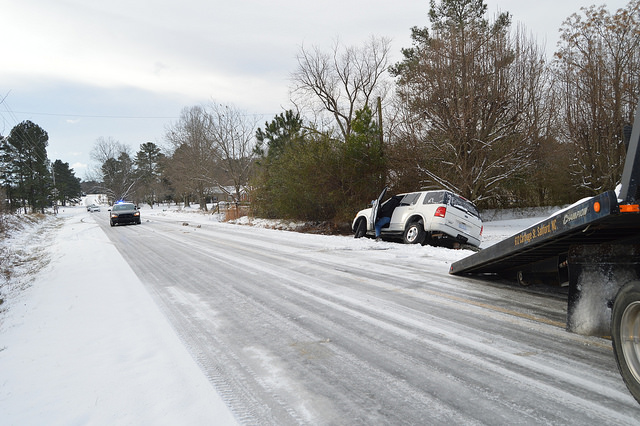While a lot of us may love the holiday season, one not so joyous thing that comes with it is the weather. What's particularly bad is that winter weather affects roads and can make driving dangerous. While fresh snow may be a pretty sight to see on Christmas morning, it’s a lot less pretty when it’s causing car collisions on the road. Unfortunately, snow, sleet, and ice, are responsible for a significant number of automobile accidents in winter months.
According to the U.S. Department of Transportation (USDOT), over 70% of roads in the U.S. are located in areas that receive at least 5 inches of snow on average each year. Nearly 70% of the U.S. population lives in these areas, meaning the vast majority of us have our drives impacted by winter weather conditions to some degree. Heavy snow and sleet reduce visibility of the road, and snow accumulation reduces the number of cars that fit on the street, as well as how fast vehicles are able to travel. On surface roads, speeds decrease by an average of 30-40% in snowy and icy conditions. On the freeway, speeds decrease by an average of 3-13% in light snow, and 5-40% in heavy snow. Snow and ice on the road also reduce pavement friction and vehicle maneuverability.
Data from the National Highway Traffic Safety Administration (NHTSA) shows that of the 5,748,000 crashes that occurred between 2005 and 2015, 1,259,000 (22%) were weather related. This is an average of about 5,900 weather related automobile accidents per year. Of crashes caused by weather, precipitation and wet pavement were the most common causes, which is unsurprising because these conditions occur year round. Of weather conditions that are specific to winter months, 17% of crashes occurred during snow or sleet, 13% occurred on icy pavement, and 14% occurred due to snowy or slushy pavement. Rapidly changing conditions, such as a sudden blizzard, are the most dangerous conditions, as road visibility can change in an instant.
Road salt is commonly used to help reduce the effects of winter weather on the road. USDOT reports that winter road maintenance makes up 20% of state DOT maintenance budgets. State and local agencies spend approximately $2.3 billion on snow and ice road repairs. Salt has proven to be extremely effective in keeping drivers safer. According to a study done by Marquette University, road salt reduces the number of car collisions by 88%, injuries by 85%, and accident costs by 85%.
It’s clear that winter weather conditions make roads more dangerous and car accidents more likely to happen. However it’s unrealistic to expect drivers to just not go anywhere when it snows (especially in Michigan, where the winters can be very, very long). The Michigan Secretary of State offers the following tips for driving in winter weather.
While following these tips can’t guarantee you won’t get into a winter car accident caused by snow or ice, it may help reduce the risk of motor vehicle collisions, and keep you and your family safer if you should be involved a car crash. The holiday season is a celebratory time of year, but it’s important to be aware of the driving hazards that also occur. These scary winter car accident statistics aren’t meant to keep you in your house all winter, but should serve as an important reminder of the additional hazards winter weather poses to driving.
While winter weather conditions do make driving more dangerous, the truth is that car crashes happen all year round. If you have been involved in an automobile accident, call The Michigan Law Firm, PLLC at 844.4MI.FIRM for a free legal consultation.


